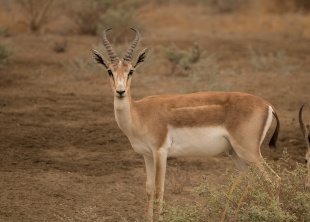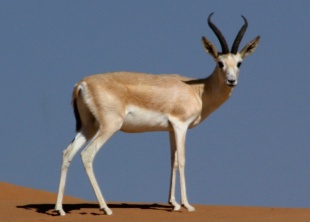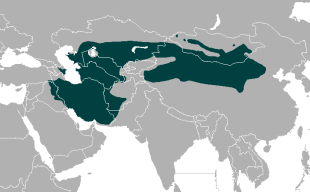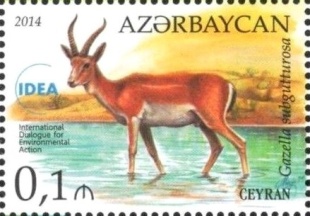GOITERED GAZELLES
Goitered gazelles (Gazella subgutturosa) are also known as black-tailed gazelles. They are native to Eurasia and found in a vast swath of Central Asia and the Middle East in Turkey, Georgia, Azerbaijan, Iran, parts of Iraq and Pakistan, Afghanistan, Tajikistan, Kyrgyzstan, Uzbekistan, Turkmenistan, Kazakhstan, northwestern China and Mongolia. Their common name and specific name (meaning "full below the throat") refers to the enlargement of the neck and throat of males during the mating season.[Source: Wikipedia]
There are estimated to be around 80,000 to 90,000 goitered gazelles in Central Asia and the Middle East. They form large herds. Small related groups break off from the herd at calving time. The large cylinder of cartilage that bulges from the male’s throat amplifies the bellowing call used to attract females and intimidate rivals in the mating season.
The lifespan of goitered gazelle in the wild can reach 12 years. In captivity they have lived up to 20 years. Their average lifespan in the wild is six years. Annual mortality rates vary in relation to sex and age class. Female mortality rates range between nine and 18 percent, whereas male mortality rates range between 27 and 58 percent. Mortality rates for calves and juveniles are highly variable, ranging between three and 58 percent. Mortality rates tend to be lowest during summer and highest during winter. Primary causes of death in goitered gazelles include deep snow and ice-covered ground, which severely limits forage availability during winter. Mortality is also caused by entrapment in drying asphalt, drowning, and car collisions. [Source: Catherine Cichon; Catherine Cichon; Yangshin Woo; Krystal Woo, Animal Diversity Web (ADW) /=]
The main predator of goitered gazelle is gray wolves. During winter, when snow cover increases, wolves become especially effective predators due to increased vulnerability of the gazelles. animals. In Iran and Turkmenistan, they are hunted by cheetahs. Young goitered gazelle are preyed on by caracals, foxes, feral dogs, imperial eagles, and brown-necked ravens.
Goitered Gazelle Subspecies
There are several subspecies of goitered gazelle, including:
1) Mongolian goitered gazelles (Gazella subgutturosa hilleriana) reside mainly in Mongolia. It is sometimes placed in the Yarkand gazelle subspecies.
2) Yarkand gazelles (Gazella subgutturosa yarkandensis) inhabit northern and northwestern China (Xinjiang, Qinghai, Shaanxi, Gansu, Nei Monggol) and Mongolia.
3) Turkmen gazelle (Gazella subgutturosa gracilicornis) live in Kazakhstan (Buzachi) in the east to about Lake Balkash as well as Turkmenistan and Tajikistan.
4) Persian goitered gazelles (Gazella subgutturosa subgutturosa) are found in southeastern Turkey, Azerbaijan, Georgia, Syria, northern and eastern Iraq, Iran, southern Afghanistan, western Pakistan [Source: Wikipedia, Catherine Cichon; Catherine Cichon; Yangshin Woo; Krystal Woo, Animal Diversity Web (ADW) /=]
Arabian sand gazelles (formerly Gazella subgutturosa marica) were long considered a subspecies, but have been recognized as a species Gazella marica since 2011. They occurs in Saudi Arabia, southern Syria, southwestern Iraq, United Arab Emirates, Oman and offshore Persian Gulf islands.
Bovids
Goitered gazelles are bovids. Bovids (Bovidae) are the largest of 10 extant families within Artiodactyla, consisting of more than 140 extant and 300 extinct species. According to Animal Diversity Web: Designation of subfamilies within Bovidae has been controversial and many experts disagree about whether Bovidae is monophyletic (group of organisms that evolved from a single common ancestor) or not. [Source: Whitney Gomez; Tamatha A. Patterson; Jonathon Swinton; John Berini, Animal Diversity Web (ADW) /=]
Wild bovids can be found throughout Africa, much of Europe, Asia, and North America and characteristically inhabit grasslands. Their dentition, unguligrade limb morphology, and gastrointestinal specialization likely evolved as a result of their grazing lifestyle. All bovids have four-chambered, ruminating stomachs and at least one pair of horns, which are generally present on both sexes.
Bovid lifespans are highly variable. Some domesticated species have an average lifespan of 10 years with males living up to 28 years and females living up to 22 years. For example, domesticated goats can live up to 17 years but have an average lifespan of 12 years. Most wild bovids live between 10 and 15 years, with larger species tending to live longer. For instance, American bison can live for up to 25 years and gaur up to 30 years. In polygynous species, males often have a shorter lifespan than females. This is likely due to male-male competition and the solitary nature of sexually-dimorphic males resulting in increased vulnerability to predation. /=\
Bovids are important food sources for a number of different carnivores. When bovid populations decline, so too do the predators that depend on them. For example, the decline of cheetahs is often attributed habitat loss. According to the International Union for Conservation of Nature (IUCN) Red List of Threatened Species, two species of gazelle are extinct, while 10 more are listed as vulnerable, endangered or critically endangered.
See Separate Article: BOVIDS: CHARACTERISTICS, BEHAVIOR, SUBFAMILIES factsanddetails.com
Ruminants
Cattle, sheep, goats, yaks, buffalo, deer, antelopes, giraffes, and their relatives are ruminants — cud-chewing mammals that have a distinctive digestive system designed to obtain nutrients from large amounts of nutrient-poor grass. Ruminants evolved about 20 million years ago in North America and migrated from there to Europe and Asia and to a lesser extent South America, where they never became widespread.
As ruminants evolved they rose up on their toes and developed long legs. Their side toes shrunk while their central toes strengthened and the nails developed into hooves, which are extremely durable and excellent shock absorbers.
Ruminants helped grasslands remain as grasslands and thus kept themselves adequately suppled with food. Grasses can withstand the heavy trampling of ruminants while young tree seedlings can not. The changing rain conditions of many grasslands has meant that the grass sprouts seasonally in different places and animals often make long journeys to find pastures. The ruminants hooves and large size allows them to make the journeys.
Describing a descendant of the first ruminates, David Attenborough wrote: deer move through the forest browsing in an unhurried confident way. In contrast the chevrotain feed quickly, collecting fallen fruit and leaves from low bushes and digest them immediately. They then retire to a secluded hiding place and then use a technique that, it seems, they were the first to pioneer. They ruminate. Clumps of their hastly gathered meals are retrieved from a front compartment in their stomach where they had been stored and brought back up the throat to be given a second more intensive chewing with the back teeth. With that done, the chevrotain swallows the lump again. This time it continues through the first chamber of the stomach and into a second where it is fermented into a broth. It is a technique that today is used by many species of grazing mammals.
See Ruminants Under MAMMALS: HAIR, HIBERNATION AND RUMINANTS factsanddetails.com
Range and Habitat of the Goitered Gazelle
Goitered gazelle are common in Kazakhstan, Mongolia and northwestern China. Elsewhere in the former range populations have significantly declined and animals that are left are found mostly in remote areas or in protected reserves. Such populations exist in western and southern Afghanistan and Pakistan. In southeastern Turkey much larger populations occur. In the central deserts of Iran, goitered gazelles are common and have begun to increase in protected regions. They have been introduced to Barsa-Kel’mes and Ogurchinsky Islands in the Aral and Caspian Sea, respectively, and to locations throughout the United Arab Emirates. [Source: Catherine Cichon; Catherine Cichon; Yangshin Woo; Krystal Woo, Animal Diversity Web (ADW) /=]
Goitered gazelles inhabit various types of desert and semiarid terrain, including deserts, steppes, semidesert grasslands, as well as foothills, mountains and mountain valleys at elevations from sea level to 3,500 meters (11,483 feet). They graze at the edge of cultivated land, but generally avoid land used for cultivation or livestock grazing. In Iran they are found from sea level to about 2,100 meters (6,890 feet); In Pakistan, and from 1,050 meters to 2,100 (3,445 to 6,890 feet). In Afghanistan they are only found below 1,000 meters (3,280 feet) . Goitered gazelle often occupy higher altitudes during summer, in the mountains of Kazakhstan, Mongolia, and China.
The habitats that goitered gazelles occupy have clayey and sandy soils and may include basalt deserts and salt flats. They can reside in areas that have virtually no vegetation but are generally found in ones that support grasses, forbs (herbaceous flowering plants) and/or shrubs. The range of goitered gazelles is restricted in the north and in mountain areas to areas where snow depths are below 10 to 15 centimeters during winter as that much snow make it difficult for the gazelles to access food. During winter they inhabit windy snow-free areas and escape from string winds in deep valleys, low mountain canyons, and dense shrubs.
Characteristics of the Goitered Gazelle
Goitered gazelle are medium-sized, lightly built ungulates; with a more robust body type than most other Asian gazelles. species. Goitered gazelles range in weight from 17.5 to 43 kilograms (38.5 to 94.7 pounds) and have a head and body length that ranges from .94 to 12.6 meters (3.1 to 4.2 feet). They stand 58 to 80 centimeters (1.9 to 2.6 feet) at the shoulder and have a 10 to 23 centimeters (4 to 9 inch) tail. Sexual Dimorphism (differences between males and females) is present: Males are larger than females. Ornamentation is different. Males have longer horns and larger goiters than females. Adult males range in weight from 20 to 43 kilograms (44 to 95 pounds) and adult females range in weight from 18 to 33 kilograms (39.6 to 73 pounds). [Source: Catherine Cichon; Catherine Cichon; Yangshin Woo; Krystal Woo, Animal Diversity Web (ADW) /=]
Goitered gazelle get their name from the goiter-like enlargement on their larynx. This large cylinder of cartilage bulges from the male’s throat amplifies the bellowing call used to attract females and intimidate rivals in the mating season. Adult males have long, black horns that are 20 to 34 centimeters (7.9 to 13.4 inches)long, which are close together at their base on the top of the head and curve away from each toward the distal ends. Unlike most other gazelle species, in which females have horns, female goitered gazelles are generally hornless.
Goitered gazelle have long ears with large black eyes. At the end of their long slender legs are small black hooves. According to Animal Diversity Web: The coxofemoral joint muscle is strengthened in goitered gazelles, enabling a strong thrusting motion that stabilizes running in rough terrain. Fur color varies geographically, from white to brown with shades of grey, red, and yellow. Facial fur is often white and tends to fade with age. They have relatively a short tail, which is covered with dark brown or black hair. In the winter their fur becomes longer, thicker, and lighter in color when compared to summer fur.
The skull of goitered gazelle has an inflated and less downwardly deflected posterior braincase. Their occipito-parietal suture is angular, the premaxillae is nearly straight, and the fronto-nasal and palato-maxillary sutures are V-shaped. In addition to their well developed lachrymal fossa (shallow, depressed area on a bone)e, they have large, inflated tympanic bullae lacking ventral ridges. Finally, the supraorbital foramina are recessed in deep pits and male skulls are easily identified by their large horn cores, also known as the cornual process. Their skull is easily distinguished from other gazelle species by its larger size, broader palate and greater orbital width. Female skulls with horns are distinguished from female mountain gazelle skulls by their slightly greater orbital and palatal width and larger lachrymal pits.
Goitered gazelle have high crowned (i.e., hypsodont) selenodont teeth. Their dental formula is 0/3, 0/1, 3/3, 3/3, for a total of 32 teeth. Calves are born with three incisors, one canine, and three deciduous cheekteeth on both sides of the lower jaw. In their upper jaw, calves are born with only three premolars on each side. During their first year, two permanent molars erupt and at 14 months, their third molar erupts along with the replacement of their deciduous molars with three premolars.
Although four inguinal mammae can form, female goitered gazelle typically have two. In general, goitered gazelle have inguinal, carpal, pedal, and preorbital glands in front of the eye sockets. The inguinal and carpal glands secrete a yellow, waxy substance with a musky odor. Their preorbital glands produce a black secretion and can be much larger in males.
Goitered Gazelle Food, Eating Behavior
Goitered gazelles are herbivores and generally eat grasses, supplemented with halophytes (plant adapted to growing in saline conditions), composites (a family of flowering plants),, caltrops (creeping plants with woody carpels and hard spines), ephedras (gymnosperm shrubs containing the stimulant ephedrine), legumes, gourds, leadworts, and tamarisks. In agricultural areas, the can eat barley shoots, fruits, chick peas, dates, cotton, corn, melons, sugar cane, onions and wheat. [Source: Catherine Cichon; Catherine Cichon; Yangshin Woo; Krystal Woo, Animal Diversity Web (ADW) /=]
Goitered gazelle are obligate herbivores with four-chambered stomachs (on true stomach, three false stomachs) which are capable of breaking down tough cellulitic materials and storing graze (in the "false stomachs"). They are facultative drinkers that get the majority of their water from the plants they eat. They appear to prefer plants with high protein content. In captivity, goitered gazelles are fed alfalfa, oats, enriched grain pellets, and sulfur-free salt blocks.
Goitered gazelles feed during early morning and afternoon in the summer and can become nocturnal (active at night), in areas where they are heavily hunted. During winter, they graze nearly continuously, resting briefly at midday. They often travel 10 to 15 kilometers throughout the day, moving between night pastures, watering holes, and resting areas.
Goitered Gazelle Behavior and Communication
Goitered gazelles are cursorial (with limbs adapted to running), terricolous (live on the ground), saltatorial (adapted to leaping), diurnal (active during the daytime), motile (move around as opposed to being stationary), solitary, territorial (defend an area within the home range) and social (associates with others of its species; forms social groups). When they are excited or disturbed, goitered gazelles perform a series of stiff-legged jumps. When running at high speeds, they gallop with their necks outstretched and tails upright. [Source: Catherine Cichon; Catherine Cichon; Yangshin Woo; Krystal Woo, Animal Diversity Web (ADW) /=]
Goitered gazelles form small groups and large herds. They generally travel in small family groups of two to nine individuals, although herds in the thousands have been recorded. During breeding season, females and young gather into herds of 10 to 30 individuals. Adult males remain solitary and become extremely territorial, patrolling and marking their territories with dung, urine, secretions from glands near their eyes, or by scraping the ground with their horns or forelegs. Small related groups break off from the herd at calving time in the spring. Pregnant females become solitary prior to giving birth and, afterwards, hide their calves while grazing. Moving them to different place every time they nurse
Goitered gazelles sense using vision, touch, sound and chemicals usually detected with smell and communicate with vision, sound and chemicals. They also leave scent marks produced by special glands and placed so others can smell and taste them. Goitered gazelles communicate using a series of deep grunts, hissing, moos and wheezing. Grunts are made by adults and young and before running, they often make a nasal hiss as an alarm. Females make hoarse, low-pitched sounds to call their young and young respond by making a low-pitched “moo”. During breeding season, males make a low, basal wheezing sound, which can be heard 100 to 150 meters away. The large cylinder of cartilage that bulges from the male’s throat amplifies the bellowing call used to attract females and intimidate rivals in the mating season. Males mark their territory and communicate with urine, dung and glandular secretions, especially during breeding season.
Goitered Gazelle Mating and Reproduction
Goitered gazelles are polygynous (males have more than one female as a mate at one time) and engage in seasonal breeding once yearly, September through January though the timing can vary. The gestation period ranges from five to six months. The number of offspring ranges from one to four.[Source: Catherine Cichon; Catherine Cichon; Yangshin Woo; Krystal Woo, Animal Diversity Web (ADW) /=]
During breeding season male goitered gazelle herd and chase females into their territories and only mate with females that remain in their territory for a period of time. Males compete for territory prior to mating season and mark their territories by defecating in small pits that they dig with their front hooves. Often, when males find a territorial pit that is already filled, they dig out the pit and refills it with their own excrement. Just prior to breeding season, glands around the eyes and groins of male goitered gazelles swell and are full of secretions at courtship time. Male displays during courtship include nose-up posturing, neck stretching, releasing pheromones, foreleg kicking, and assuming an erect posture. Courtship begins after females stay in a male’s territory overnight. Most males mate with two to 12 females, however, some males do not mate at all. Males mount their mates by standing on their hind legs with their forelegs spread apart and touching the female with only their pelvis.
The first estrus usually occurs between six and 18 months, although some females can conceive at five months old. Males can sire offspring as early as 10.5 months old but generally do not usually mate before 1.5 to 2.5 years old and can remain reproductively active for over 10 years. According to Animal Diversity Web: Onset of spermatogenesis occurs when the testis reach two centimeters in diameter. Males experience seasonal sperm production, which peaks during fall and spring. Estrus usually lasts for about 12 hours, signaled by a slight swelling of the vulva. Copulation last one to three seconds,
Goitered Gazelle Offspring and Parenting
Goitered gazelles young are precocial. This means they are relatively well-developed when born. Parental care is provided by females. The age in which they are weaned ranges from three to six months and the average time to independence is six months. Females reach sexual or reproductive maturity as early as five months, with the average being 12 months. Males reach sexual or reproductive maturity as early as 10.5 months, with average being 12 months. [Source: Catherine Cichon; Catherine Cichon; Yangshin Woo; Krystal Woo, Animal Diversity Web (ADW) /=]
Females move to areas with high ground or vegetative cover prior to birthing. Young are usually born between March and May. Most adult females (three to seven years old) have twins, although young and old females generally give birth to a single calf. On average, calves weigh 1.86 kilograms at birth. Young that can stand and nurse within 10 to 15 minutes after birth. After birth, females tend to graze 50 to 500 meters from their calves and seek a new hiding place for their calves after each nursing bout. If a female has twins, she often keeps them 50 to 1,000 meters apart for the first four to six days. Calves are nursed two to four times a day during their first six weeks and are nursed for at least three to six months.
Goitered gazelle calves are able to graze and drink water at four to six weeks old. They have very high growth rates during their first month of life, with 50 percent of their growth occurring within the first 10 days after birth. At 18 to 19 months, most calves have reached adult size. Calves are born with whirls of hair were their horns develop. Horn growth occurs at three to six months and is complete by one to 1.5 years. Male horns continue to grow until age 6, whereas female's reach full size by two to three years old. /=\
Goitered Gazelles, Humans and Conservation
On the International Union for Conservation of Nature (IUCN) Red List, goitered gazelles are listed as Vulnerable. On the US Federal List they are classified as Endangered. In CITES (Convention on International Trade in Endangered Species of Wild) they have no special status. [Source: Catherine Cichon; Catherine Cichon; Yangshin Woo; Krystal Woo, Animal Diversity Web (ADW) /=]
Goitered gazelles are hunted for their meat and hide, which is considered high quality and is processed into chamois and box calf. A single goitered gazelle yields between 12 and 18 kilograms of meat and 0.6 to 0.7 square meters of hide. Goitered gazelle are hunted for sport. They are considered a challenge because they can to run at high speeds. The are sometimes kept as pets or given as gifts. Goitered gazelles occasionally damage agricultural plants such as cotton. They also consume saxaul shoots, which is considered one of the most valuable desert plants in their range. In spring and fall, they often intrude into domestic sheep pastures. /=\
In 1900s, goitered gazelles were abundant, found in almost every desert or semi-desert area throughout the Middle East and Central Asia. In the mid-1900s, nearly one million were estimated to have lived in the Soviet Union alone. But by 2001, their entire population was estimated at 120,000 to 140,000, with the greatest rate of decrease in the 1990s and 2000s. While population declines have occurred throughout their entire range, declines have been most severe in Turkmenistan, Kazakhstan, southeast Turkey and Azerbaijan. Local extirpations have occurred in Kuwait, Georgia, and possibly Kyrgyzstan. Populations in Mongolia, where about a half the current population resides, are also in decline. Major threats include hunting, poaching and habitat destruction due primarily to livestock and agricultural development. In Central Asia, harsh winters can have a strong negative impact on goitered gazelle populations. Many gazelle die from malnutrition at that time.
In the mid to late 1300s, the armies of Timurlane were noted hunters of goitered gazelle, killing an estimated 40,000 each year. After automobiles were introduced in the 1930s, hunting for goitered gazelles became particularly easy as people would chase animals in their cars during the day, or shoot them at night while "shining" them (i.e., using artificial lights to locate and temporarily freeze animals) with their headlights. Using automobiles to hunt goitered gazelles was outlawed in the Union of Soviet Socialist Republics in the 1940s.
Since the 1950s, legal protection has been set up both nationally or sub-nationally throughout most of goitered gazelles' geographic range. Numerous reintroductions have been attempted, but have largely been unsuccessful. Some countries such as Turkey and Uzbekistan have developed captive breeding programs and much of the current population lives in protected areas. Future conservation efforts may include restricting livestock grazing areas during winter or restricting livestock from entering habitat reserves used by goitered gazelles. /=\
Image Sources: Wikimedia Commons
Text Sources: Animal Diversity Web animaldiversity.org ; National Geographic, Live Science, Natural History magazine, CNTO (China National Tourism Administration) David Attenborough books, New York Times, Washington Post, Los Angeles Times, Smithsonian magazine, Discover magazine, The New Yorker, Time, BBC, CNN, Reuters, Associated Press, AFP, Lonely Planet Guides, Wikipedia, The Guardian, Top Secret Animal Attack Files website and various books and other publications.
Last updated April 2025





